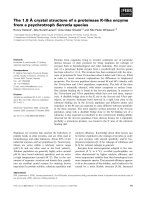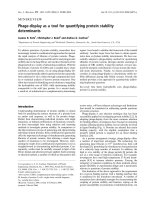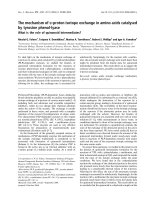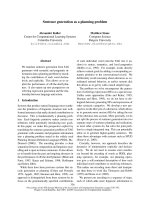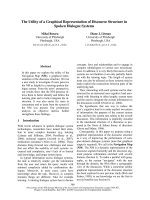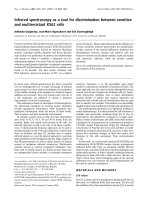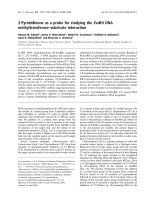Báo cáo khoa hoc:" The chicken as a model to study microchromosomes in birds: a review" potx
Bạn đang xem bản rút gọn của tài liệu. Xem và tải ngay bản đầy đủ của tài liệu tại đây (722.48 KB, 11 trang )
Review
The
chicken
as
a
model
to
study
microchromosomes
in
birds:
a
review
Valérie
Fillon
Laboratoire
de
génétique
cellulaire,
Institut
national
de
la
recherche
agronomique,
BP27,
31326
Castanet-Tolosan
cedex,
France
(Received
17
December
1997;
accepted
22
April
1998)
Abstract -
The
typical
avian
karyotype
is
composed
of
a
few
macrochromosomes
and
around
60
indistinguishable
small
microchromosomes.
Due
to
its
economic
importance,
the
chicken
is
the
avian
species
for
which
cytogenetic
and
genetic
maps
are
the
most
developed.
Based
on
these
genome
studies,
it
has
been
shown
that
the
chicken
microchromosomes
are
carriers
of
dense
genetic
information.
Indeed,
they
probably
bear
at
least
50
%
of
the
genes
and
exhibit
high
recombination
rates.
Because
of
the
presence
of
microchromosomes,
the
genetic
size
of
the
chicken
genome
seems
higher
than
first
estimated
and
could
reach
more
than
4 000 cM
for
1 200 Mb.
Thus,
it
is
worth
developing
the
microchromosome
map.
From
an
evolutionary
point
of
view,
comparative
mapping
data
raise
many
questions
about
the
origin
of
microchromosomes.
They
could
be
ancestral
chromosomes,
from
which
large
chromosomes
formed
by
fusions,
or
conversely
they
could
be
the
result
of
the
splitting
of
macrochromosomes. ©
Inra/Elsevier,
Paris
microchromosome
/
chicken
/
genomic
map
/
recombination
rate
Résumé -
La
Poule
comme
modèle
d’étude
des
microchromosomes
d’oiseaux :
une
revue.
Le
caryotype
aviaire
typique
est
constitué
de
quelques
macrochromosomes
et
d’environ
soixante
microchromosomes
punctiformes
et
indiscernables
les
uns
des
autres.
Du
fait
de
son
importance
économique,
la
Poule
est
l’espèce
d’oiseaux
dont
les
cartes
génétique
et
cytogénétique
sont
les
plus
avancées.
Ces
études
ont
permis
de
montrer
que
les
microchromosomes
contiennent
une
information
génétique
dense.
En
effet,
ils
portent
probablement
au
moins
50
%
des
gènes
et
ils
ont
des
taux
de
recombinaison
élevés.
Du
fait
de
la
présence
des
microchromosomes,
la
taille
génétique
attendue
pour
le
génome
de
la
Poule
est
d’au
moins
4 000
cM
pour
1200
Mb.
Il
apparaît
donc
important
de
densifier
la
carte
génétique
des
microchromosomes.
Du
point
de
vue
évolutif,
les
données
de
cartographie
comparée
soulèvent
de
nombreuses
questions
quant
à
l’origine
des
microchromosomes.
Ils
pourraient
être
des
caractères
ancestraux
ayant
permis
la
formation
des
grands
chromosomes
par
fusion,
ou au
contraire
être
le
résultat
de
plusieurs
fissions
chromosomiques. @
Inra/Elsevier,
Paris
microchromosome
/
poule
/
carte
génomique
/
taux
de
recombinaison
E-mail:
INTRODUCTION
Microchromosomes
were
discovered
in
the
first
chicken
chromosome
prepa-
rations
and
were
then
considered
as
small
genetically
inert
accessory
elements,
totally
heterochromatic,
without
any
gene
or
centromere
and
constituting
a
reserve
of
nucleic
acids
for
chromosomal
replication
(57!.
Later
observations,
demonstrating
their
constant
number
in
the
karyotype
of
different
studied
species,
led
to
their
being
considered
as
genuine
chromosomes
[41,
58,
78],
although
they
were
thought
to
exhibit
no
recombination
in
order
to
preserve
ancestral
linkage
groups
(73].
Birds
are
the
vertebrates
that
have
the
greatest
number
of
microchromo-
somes.
The
typical
avian
karyotype
is
composed
of
around
80
chromosomes
sep-
arated
into
two
classes:
a
few
distinguishable
macrochromosomes
and
a
much
higher
number
of
small
microchromosomes,
visualized
as
dots
on
metaphase
preparations
and
usually
classified
by
decreasing
size
(17!.
Except
for
the
Fal-
coniformes
and
particularly
the
Accipitridae
family
which
has
no
more
than
three
to
six
microchromosome
pairs
(24!,
the
average
number
of
microchromo-
somes
is
60
[17,
77!.
Depending
on
the
species,
the
borderline
between
both
groups
is
not
always
clear.
The
usual
criteria
used
to
define
microchromosomes
are
mainly
their
size
(which
varies
according
to
authors
between
0.5
and
1.5
u.m
(44!),
the
impossibility
of
distinguishing
them
from
each
other
and
of
defining
the
centromere
position
(77!.
Because
of
its
economic
importance,
the
chicken
is
the
avian
species
for
which
cytogenetic
and
genetic
maps
are
the
most
developed
and
important
international
efforts
are
under
way
to
build
up
a
complete
genome
coverage,
making
it
a
reference
for
the
detailed
study
of
bird
genomes.
2.
THE
CHICKEN
KARYOTYPE
Although
the
boundary
between
macro-
and
microchromosomes
varies
ac-
cording
to
authors,
the
actual
standard
karyotype
description
by
GTG-
and
RBG-banding
for
the
chicken,
established
by
the
International
Committee
for
the
Standardization
of
the
Avian
Karyotype,
concerns
eight
pairs
of
macrochromosomes
and
sex
chromosomes
Z
and
W
(ICSAK,
1993:
K.
Ladjali,
J.J.
Bitgood,
R.N.
Schoffner
and
F.A.
Ponce
de
Leon;
[42]).
The
remaining
30
pairs
of
chromosomes
are
referred
to
as
microchromosomes
and
only
an
approximate
size
can
usually
be
given
for
individual
descriptions.
Indeed,
due
to
their
smaller
size
and
lower
degree
of
chromatin
compaction
(68],
it
is
im-
possible
to
obtain
characteristic
banding
patterns
for
each
pair.
However,
by
using
DAPI
or
chromomycin
A3
staining,
it
has
been
suggested
that
most
of
the
microchromosomes
had
lower
(A
+
T)
and
higher
(G
+
C)
contents
than
the
macrochromosomes
[2,
30!.
This
specific
structure
was
confirmed
by
the
fact
that
the
microchromosomes
replicate
earlier
[63,
71]
and
also
that
a
high
proportion
of
CpG
islands
is
located
on
them
(47!.
The
only
chicken
microchromosome
pair
that
has
been
given
a
number
is
the
one
bearing
the
nucleolar
organizer
region,
visible
after
silver
staining,
and
the
major
histocom-
patibility
complex
(MHC).
It
is
usually
referred
to
as
chromosome
number
16
[2,
5].
More
recently,
electron
microscopic
analyses
on
chicken
synaptonemal
complexes
enabled
confirmation
that
microchromosomes
account
for
30
%
of
the
chicken
genome
and
determination
of
the
position
of
the
centromeres.
Most
microchromosomes
were
thus
found
to
be
acrocentric
(37].
The
physical
size
of
the
chicken
genome
is
1 200
Mb:
the
mean
size
for
chicken
macrochromosomes
is
around
130
Mbases,
and
only
12.5
Mbases
for
microchromosomes,
with
the
smallest
one
estimated
to
be
as
small
as
7
Mbases
(6!.
3.
THE
CHICKEN
GENOMIC
MAP
Chicken
genetic
maps
are
composed
of
around
650
molecular
markers
[13,
43!.
The
genetic
size
is
between
2 500
and
3 400
cM.
They
are
composed
of
a
small
number
of
large
linkage
groups
that
have
been
assigned
to
macrochromo-
somes,
and
numerous
small
linkage
groups
or
independent
markers
probably
corresponding
to
microchromosomes,
but
for
which
a
cytogenetic
localization
still
needs
to
be
defined
[7,
9,
13,
15,
21,
43].
Recognizing
each
individual
mi-
crochromosome
is
essential
to
allow
a
precise
localization
of
genes
and
markers,
leading
to
completed
genetic
maps.
For
this
purpose,
a
collection
of
large
insert
BAC
(bacterial
artificial
chromosome)
and
PAC
(bacteriophage
PI
artificial
chromosome)
clones
[80]
to
be
used
as
microchromosome
tags
for
identification
in
two-colour
FISH
experiments
has
been
developed
[29]
enabling
the
individual
characterization
of
16
microchromosome
pairs.
These
clones
have
also
permit-
ted
14
linkage
group
assignments
(Morisson,
pers.
comm.).
The
identification
of
microchromosome
pairs
leading
to
the
integration
of
the
genetic
and
cytoge-
netic
maps
is
the
first
step
towards
a
better
knowledge
of
microchromosomes,
especially
with
regards
their
genetic
composition
and
their
recombination
rates.
4.
THE
GENETIC
COMPOSITION
OF
MICROCHROMOSOMES
4.1.
The
density
of
genes
Despite
their
very
small
size,
microchromosomes
seem
to
hold
many
genes.
CpG
islands,
which
are
short
unmethylated
CpG-rich
sequences
located
towards
the
5
end
of
many
vertebrate
genes
[1],
are
enriched
on
microchro-
mosomes
[47].
This
suggests
the
presence
of
a
higher
gene
density
than
on
macrochromosomes.
Indeed,
more
than
half
of
the
mapped
genes
have
been
localized
on
chicken
microchromosomes,
confirming
their
genetic
importance
[62],
whereas
less
than
40
%
of
the
genetically
mapped
genes
are
localized
on
macrochromosomes
1-4
which
represent
50
%
of
the
chicken
genome
[Chick
GBase
(
].
Moreover,
it
has
been
demonstrated
for
a
few
genes
that
the
size
of
chicken
intronic
sequences
is
shorter
than
for
human
homologues
[32,
34!.
Microchro-
mosome
16
confirms
this
high
density
of
genes
as
it
carries
the
rDNA
genes
(2!,
major
histocompatibility
complexes
B
[5,
26]
and
R f p-Y
(28!,
the
lectin
genes
[4]
and
a
few
other
genes
(ChickGBase).
This
high
gene
density
demonstrates
that
it
is
worth
developing
the
genetic
map
of
microchromosomes.
4.2.
The
distribution
of
repeated
sequences
Highly
repeated
sequences
correspond
to
36
%
of
the
human
genome
and
12
%
of
the
chicken
genome
[6].
It
is
thought
that
the
chicken
genome
and
especially
microchromosomes
lack
repetitive
DNA
because
of
loss
or
non-
acquisition
of
such
sequences.
However,
constitutive
heterochromatin
is
located
essentially
on
chromosomes
Z
or
W and
some
microchromosomes,
whereas
macrochromosomes
are
weakly
stained
in
C-banding
studies
[11,
61,
74].
Moreover,
repeated
sequences
enriched
on
microchromosomes
have
been
cloned.
The
first
one,
isolated
from
chicken,
represents
10
%
of
the
genome
and
probably
concerns
centromeric
heterochromatin
(45].
The
second
corresponds
to
5
%
of
the
turkey
genome
and
is
located
on
one
third
of
the
microchromosomes
(46J.
Some
clones
showing
repeated
hybridization
patterns
localized
specifically
on
microchromosome
pairs
have
also
been
reported
(29J.
Thus,
despite
their
high
gene
density
and
their
small
size,
microchromosomes
do
not
lack
repeated
DNA.
Microsatellites
are
repeated
sequences
of
particular
value
for
genome
map-
ping
as
they
have
been
shown
to
be
highly
polymorphic
in
the
chicken
[14,
18J.
But
the
frequency
of
different
types
of
microsatellites
differs
between
birds
and
mammals.
The
frequency
of
dinucleotides
(CA)n
in
birds
is
one
fifth
of
that
in
mammals.
There
are
7 000-9 000
(CA)n
in
the
chicken
genome,
spread
every
136-150
kb,
instead
of
every
30
kb
in
human
[53,
65J.
Moreover,
they
seem
to
be
concentrated
on
macrochromosomes
based
on
PRINS
experiments
(65].
The
low
proportion
of
(CA)n
in
the
chicken
genome
was
confirmed
by
high
stringency
screening
of
PAC
and
BAC
libraries
(Morisson,
pers.
comm.).
However,
about
one
third
of
these
clones
were
localized
on
microchromosomes
by
FISH,
sug-
gesting
homogeneous
distribution
of
(CA)n
microsatellites
between
macro-
and
microchromosomes.
It
would
be
interesting
to
screen
for
tri-
or
tetra-nucleotide
repeats
as
they
seem
more
frequent
in
the
chicken
genome
(53J.
5.
THE
RECOMBINATION
RATE
OF
MICROCHROMOSOMES
At
least
one
chiasma
per
chromosome
is
needed
regardless
of
its
size
[12,
27,
36J.
Indeed,
chiasma
analyses
on
chicken
lampbrush
chromosomes
demon-
strated
that
in
microchromosomes
one
or
two
crossing-over
events
may
oc-
cur:
on
average
one
per
11-12
Mb,
whereas
avian
macrochromosomes
have
one
crossing-over
per
30
Mb
[66,
69,
70J.
Despite
their
small
size,
microchromosomes
would
thus
have
an
associated
linkage
group
of
at
least
50
cM
and
therefore
a
high
genetic
to
physical
distance
ratio.
Thus,
the
two
genetically
independent
major
histocompatibility
complexes
B and
R f p-Y
[51,
52]
have
been
located
on
the
same
microchromosome
16,
demonstrating
the
occurrence
of
recombi-
nations
(28J.
Moreover,
based
on
mapping
of
anonymous
molecular
markers,
it
has
recently
been
shown
in
several
cases
that
the
linkage
groups
corresponding
to
microchromosomes
are
more
than
50
cM
long
(Morisson,
pers.
comm.).
Due
to
the
presence
of
microchromosomes,
but
also
because
of
the
great
number
of
chromosomes,
the
recombination
potential
of
the
chicken
genome
is
high.
Indeed,
the
segregation
of
parental
chromosomes
during
meiosis
allows
a
mixing
of
the
genetic
material.
The
recombination
index
(RI)
calculated
(RI
=
n
+
TC,
where
n
is
the
number
of
bivalents
and
TC
the
total
number
of
chiasmatas)
is
90-100
in
birds,
whereas
it
is
on
average
50
in
mammals
[68].
Moreover,
the
domestic
species
studied
(dog,
cat,
pig,
cattle,
etc.)
tend
to
have
higher
chiasma
frequencies
[8].
These
values
could
be
due
to
the
intense
selection
effort
on
small
livestock
populations
sometimes
changing
allelic
associations
between
closely
linked
genes,
and
creating
new
haplotypes.
According
to
the
values
found
in
the
chicken,
the
potential
response
of
avian
genomes
to
selection
could
be
very
high.
However,
if
the
recombination
rate
is
very
high,
saturated
genetic
maps
would
be
necessary
to
have
very
close
markers
available
each
time
in
order
to
permit
a
molecular
marker-assisted
selection.
The
current
genetic
maps
contain
around
650
genetic
markers
[13].
However,
the
genome
coverage
is
not
achieved
as
10
%
of
new
mapped
markers
are
still
unlinked.
Moreover,
the
genetic
size
of
microchromosomes
is
high
compared
to
their
physical
size.
We
may
still
expect
a
total
genetic
size
as
large
as
4
000
cM
for
1 200
Mb.
Thus,
to
detect
QTL
S,
1000-1200
markers
will
be
needed
on
the
map,
so
as
to be
able
to
choose
a
high
quality
subset
of
200-400
markers
[20,
21].
Thus,
more
molecular
markers
should
be
developed,
especially
for
microchromosomes.
6.
THE
EVOLUTIONARY
MEANING
OF
MICROCHROMOSOMES
Some
regions
of
conserved
syntenies,
involving
2-6
loci,
have
already
been
described
between
birds
and
mammals,
although
they
diverged
some
300
mil-
lion
years
ago
[9,
10].
Most
of
them
concern
macrochromosomes.
For
example,
chicken
chromosome
1
corresponds
to
human
chromosomes
11,
12,
15
and
17
[40],
and
some
genes
of
the
chicken
chromosome
7q
are
conserved
on
human
chromosome
2q
[31,
33].
Two
cases
involving
chicken
microchromosomes
have
also
been
reported.
The
first
syntenic
group
is
composed
of
three
genes
[35,
67]
located
on
a
25-Mb
microchromosome
and
on
human
chromosome
15q,
proba-
bly
in
the
same
order
[35].
The
second
example
shows
that
human
chromosome
17q
corresponds
to
at
least
four
chicken
chromosomes,
including
chromosome
Z
[19,
38],
chromosome
1
[72]
and
two
different
microchromosomes
[60].
This
sug-
gests
that
numerous
rearrangements
have
occurred
and
raises
interesting
ques-
tions
about
the
evolution
of
vertebrate
genomes,
such
as
whether
the
microchro-
mosomes
originate
from
splitting
large
chromosomes
or
the
macrochromosomes
originate
from
aggregation
of
small
ones.
Microchromosomes
may
contain
syn-
tenic
groups
well
conserved
within
vertebrates.
Avian
microchromosomes
may
represent
ancient
genome
structures
that
have
aggregated
together
in
other
species
to
give
rise
through
evolution
to
larger
structures.
If
they
have
not
been
rearranged
with
other
chromosomes
during
avian
evolution,
they
might
carry
ancient
gene
combinations
and
their
study
would
give
insights
into
the
general
evolution
of
vertebrate
karyotypes.
The
current
progress
in
mapping
chicken
genes
will
generate
more
comparative
mapping
data,
and
will
enable
us
to
test
this
hypothesis
by
further
estimating
the
degree
of
rearrangements
between
mammals
and
birds.
Microchromosomes
are
also
present
in
lower
numbers
in
a
few
other
verte-
brates
(fish,
batracians,
reptiles)
and
tend
to
disappear
completely
in
mam-
mals
[68].
According
to
Rodionov
[68],
it
might
be
tempting
to
consider
them
as
ancestral
chromosomes
although
they
are
very
rare
in
fish
and
batracians.
Indeed,
they
could
have
been
inherited
from
a
common
ancestor
of
the
ver-
tebrates,
as
they
can
be
encountered
in
primitive
orders
such
as
cartilaginous
fish
[59,
75],
salamanders
[55]
or
monotreme
[79].
Moreover,
general
features
of
bird
karyotypes
seem
very
well
conserved
between
ratites
and
carinatas
!17!.
The
appearance
of
microchromosomes
could
precede
bird
adaptative
radia-
tion
at
the
end
of
the
Jurassic,
beginning
of
the
Cretaceous
[16].
However,
crocodilians
!39!,
which
are
closer
to
birds,
have
karyotypes
without
any
mi-
crochromosome,
as
do
frogs
[54].
In
reptiles
[48,
64,
76]
and
amphibians
[55],
only
a
small
number
of
chromosomes
can
be
thought
to
be
microchromosomes.
We
note
as
well
that
most
of
the
bird
species
show
a
typical
karyotype
with
around
60
microchromosomes,
although
the
Accipitridae
have
only
three
to
six
pairs
of
microchromosomes
[22,
23,
24].
In
Ciconiiformes,
there
is
an
im-
portant
reduction
in
the
number
of
chromosomes
(50-60)
and
only
around
20
microchromosomes
[3,
25!.
Furthermore,
there
is
an
increase
in
the
number
of
chromosomes
and
microchromosomes
in
the
Coraciiformes,
where
more
than
100
microchromosomes
are
found
[17,
77!.
At
the
current
level
of
knowledge,
there
are
no
data
to
explain
the
high
num-
ber
of
microchromosomes
in
bird
karyotypes.
If
it
is
the
ancestral
situation,
we
could
imagine
that
mammalian
chromosomes
have
been
formed
by
the
fusion
of
microchromosomes
and/or
the
acquisition
of
non-coding
DNA
sequences.
When
the
number
of
macrochromosomes
increases,
the
number
of
microchromosomes
diminishes;
higher
proportions
of
acrocentric
chromosomes
are
found
in
species
with
larger
numbers
of
microchromosomes,
and
more
metacentric
or
submeta-
centric
macrochromosomes
are
found
in
species
with
fewer
microchromosomes
!77!.
Robertsonian
fusions
or
translocations
could
occur
between
chromosomes,
leading
to
the
formation
of
two
very
distinct
groups
of
chromosomes
[44,
68,
77!.
The
presence
of
many
telomeric,
pericentromeric
or
interspersed
sequences
in
the
chicken
genome
could
be
the
evidence
for
such
chromosomal
rearrange-
ments
(56].
However,
some
species
(among
Passeriformes)
have
only
a
telomeric
distribution
of
(TTAGGG)n
sequences
(50!.
This
sequence,
very
well
conserved
in
vertebrates,
is
located
on
every
telomere,
which
is
also
true
for
microchro-
mosomes
[49].
In
reptiles,
fish
and
amphibians,
hybridization
signals
were
also
found
in
pericentromeric
or
interstitial
regions
for
some
species
[50].
But
mi-
crochromosomes
could
also
be
the
result
of
chromosome
fissions,
in
which
case
(TTAGGG)n
interstitial
sites
would
be
interpreted
as
being
regions
existing
prior
to
the
formation
of
new
telomeres
!50!.
7.
CONCLUSION
Microchromosomes
are
genuine
chromosomes,
probably
bearing
at
least
50
%
of
the
genes
in
the
chicken
and
exhibiting
high
recombination
rates.
It
makes
sense
to
approach
the
chicken
genome
by
developing
the
genetic
map
of
microchromosomes.
Microsatellite
sequences
seem
to
be
uniformly
spread
within
the
genome,
and
could
provide
new
molecular
markers
even
if
they
are
less
frequent
than
in
mammals.
Although
microchromosomes
carry
dense
genetic
information,
they
also
have
several
families
of repeated
DNA
sequences.
Further
studies
on
specific
chromo-
some
repeated
sequences
could
give
valuable
information
on
the
organization
of
microchromosomes,
especially
the
centromeric
sequences.
In
the
longer
term,
microdissection
of
chromosomes
or
large
scale
sequencing
could
enable
us
to
refine
our
knowledge
of
specific
microchromosomal
regions.
Despite
all
the
comparative
data
available,
it
is
still
difficult
to
understand
the
evolutionary
meaning
of
microchromosomes.
The
presence
of
conserved
segments
in
mammals
and
birds
allows
the
reconstitution
of
some
chromosome
rearrangements
and
the
discovery
of
probably
ancient
groups
of
genes.
The
re-
maining
question
is
the
direction
of
chromosome
evolution.
Microchromosomes
could
be
ancestral,
at
the
origin
of
large
chromosomes
by
fusion
or
conversely
originate
from
macrochromosomes
by
splitting.
REFERENCES
[1]
Antequera
F.,
Bird
A.,
Number
of
CpG
islands
and
genes
in
human
and
mouse,
Proc.
Natl.
Acad.
Sci.
USA
90
(1993)
11995-11999.
[2]
Auer
H.,
Mayr
B.,
Lambrou
M.,
Schleger
W.,
An
extended
chicken
kary-
otype,
including
the
NOR
chromosome,
Cytogenet.
Cell
Genet.
45
(1987)
218-221.
[3]
Belterman
R.H.R.,
De
Boer
L.E.M.,
A
karyological
study
of
55
species
of
birds,
including
karyotypes
of
39
species
new
to
cytology,
Genetica
65
(1984)
39-82.
[4]
Bernot
A.,
Zoorob
R.,
Auffray
C.,
Linkage
of
a
new
member
of
the
lectin
supergene
family
to
chicken
MHC
genes,
Immunogenetics
39
(1994)
221-229.
[5]
Bloom
S.E.,
Bacon
L.D.,
Linkage
of
the
major
histocompatibility
(B)
complex
and
the
nucleolar
organizer
in
the
chicken,
J.
Hered.
76
(1985)
146-154.
[6]
Bloom
S.E.,
Delany
M.E.,
Muscarella
D.E.,
Constant
and
variable
features
of
the
avian
chromosomes,
in:
Etches
R.J.,
Gibbins
A.M.V.
(Eds.),
Manipulation
of
the
Avian
Genome,
CRC
press,
Guelph,
Canada,
1993,
pp.
39-59.
[7]
Bumstead
N.,
Palyga
J.,
A
preliminary
linkage
map
of
the
chicken
genome,
Genomics
13
(1992)
690-697.
[8]
Burt
A.,
Bell
G.,
Mammalian
chiasma
frequencies
as
a
test
of
two
theories
of
recombination,
Nature
326
(1987)
803-805.
[9]
Burt
D.W.,
Bumstead
N.,
Bitgood
J.J.,
Ponce
de
Leon
F.A.,
Crittenden
L.B.,
Chicken
genome
mapping:
a
new
era
in
avian
genetics,
Trends
Genet.
11
(1995)
190-194.
[10]
Burt
D.W.,
Jones
C.T.,
Morrice
D.R.,
Taton
I.R.,
Mapping
the
chicken
genome -
An
aid
to
comparative
studies,
Anim.
Genet.
27
(suppl.
2)
(1996)
66.
!11!
Carlenius
C., Ryttman
H., Tegelstr6m
H., Jansson
H.,
R-,
G-
and
C-banded
chromosomes
in
the
domestic
fowl
(Gallus
domesticus),
Hereditas
94
(1981)
61-66.
[12]
Carpenter
A.T.C.,
Chiasma
function,
Cell
77
(1994)
959-962.
[13]
Cheng
H.H.,
Mapping
the chicken
genome,
Poult.
Sci.
76
(1997)
1101-1107.
[14]
Cheng
H.H.,Crittenden
L.B.,
Microsatellite
markers
for
genetic
mapping
in
the
chicken,
Poult.
Sci.
73
(1994)
539-546.
[15]
Cheng
H.H.,
Levin
I.,
Vallejo
R.L.,
Khatib
H.,
Dodgson
J.B.,
Crittenden
L.B.,
Hillel
J.,
Development
of
a
genetic
map
of
the
chicken
with
markers
of
high
utility,
Poult.
Sci.
74
(1995)
1855-1874.
[16]
Chiappe
L.M.,
The
first
85
million
years
of
avian
evolution,
Nature
378
(1995)
349-355.
[17]
Christidis
L.,
Animal
Cytogenetics,
4
chordata
3,
Aves,
Gebriider
Born-
traeger,
Berlin,
1990.
[18]
Crooijmans
R.P.M.A.,
Van
Kampen
A.J.A.,
Van
der
Poel
J.J.,
Groenen
M.A.M.,
Highly
polymorphic
microsatellite
markers
in
poultry,
Anim.
Genet.
24
(1993)
441-443.
[19]
Crooijmans
R.P.M.A., Van
der
Poel
J.J., Groenen
M.A.M.,
Functional
genes
mapped
on
the chicken
genome,
Anim.
Genet.
26
(1995)
73-78.
[20]
Crooijmans
R.P.M.A.,
Groen
A.B.F.,
Van
Kampen
A.J.A.,
Van
des
Beek
S., Van
der
Poel
J.J., Groenen
M.A.M.,
Microsatellite
polymorphism
in
commercial
broiler
and
layer
lines
estimated
using
pooled
blood
samples,
Poult.
Sci.
75
(1996)
904-909.
[21]
Crooijmans
R.P.M.A.,
Van
Oers
P.A.M.,
Strijk
J.A.,
Van
der
Poel
J.J.,
Groenen
M.A.M.,
Preliminary
linkage
map
of
the
chicken
(Gallus
gallus
domesti-
cus)
genome
based
on
microsatellite
markers,
77
new
markers
mapped,
Poult.
Sci.
75
(1996)
746-754.
[22]
De
Boer
L.E.M.,
Karyological
heterogeneity
in
the
Falconiformes
(Aves),
Experentia
31
(1975)
1135-1139.
[23]
De
Boer
L.E.M.,
The
somatic
chromosome
complements
of
16
species
of
Falconiformes
(Aves)
and
the
karyological
relationships
of
the
order,
Genetica
65
(1976)
77-113.
[24]
De
Boer
L.E.M.,
Sinoo
R.P.,
A
karyological
study
of
Accipitridae
(Aves:
Falconiformes),
with
karyotypic
descriptions
of
16
species
new
to
cytology,
Genetica
65
(1984)
89-107.
[25]
De
Boer
L.E.M.,
Van
Brink
J.M.,
Cytotaxonomy
of
the
Ciconiiformes
(Aves),
with
karyotypes
of
eight
species
new
to
cytology,
Cytogenet.
Cell
Genet.
34
(1982)
19-34.
[26]
Dominguez-Steglich
M., Auffray
C., Schmid
M.,
Linkage
of
the chicken
MHC
to
the
nucleolus
organiser
region
visualised
using
non-isotopic
in
situ
hybridization,
J.
Hered.
82
(1991)
503-505.
[27]
Dutrillaux
B.,
Le
role
des
chromosomes
dans
1’evolution :
une
nouvelle
interpretation,
Ann.
Genet.
29
(1986)
69-75.
’
[28]
Fillon
V.,
Zoorob
R.,
Yerle
M.,
Auffray
C.,
Vignal
A.,
Mapping
of
the
genetically
independant
chicken
major
histocompatibility
complexes
B@
and
RFP-
Y@
to
the
same
microchromosome
by
two-color
fluorescent
in
situ
hybridization,
Cytogenet.
Cell
Genet.
75
(1996)
7-9.
[29]
Fillon
V.,
Morisson
M.,
Zoorob
R.,
Auffray
C.,
Douaire
M.,
Gellin
J.,
Vignal
A.,
Identification
of
16
chicken
microchromosomes
by
molecular
markers
us-
ing
two-colour
Fluorescent
In
Situ
Hybridisation
(FISH),
Chromosome
Res.
(1998)
in
press.
[30]
Fritschi
S.,
Stranzinger
G.,
Fluorescent
chromosome
banding
in
inbred
chicken:
quinacrine
bands,
sequential
chromomycin
and
DAPI
bands,
Theor.
Appl.
Genet.
71
(1985)
408-412.
[31]
Girard-Santosuosso
0.,
Bumstead
N.,
Lantier
I.,
Protais
J.,
Colin
P.,
Guil-
lot
J F.,
Beaumont
C.,
Malo
D.,
Lantier
F.,
Partial
conservation
of
the
mam-
malian
NRAMP1
syntenic
group
on
chicken
chromosome
7,
Mamm.
Genome
8
(1997)
614-616.
[32]
Guillemot
F.,
Kaufman
J.F.,
Skjoedt
K.,
Auffray
C.,
The
major
histocom-
patibility
complex
in
the
chicken,
Trends
Genet.
20
(1989)
145-155.
[33]
Hu
J.,
Bumstead
N.,
Burke
D.,
Ponce
de
Leon
F.A.,
Skamene
E.,
Gros
P.,
Malo
D.,
Genetic
and
physical
mapping
of
the
natural
resistance-associated
macro-
phage
protein
1
(NRAMPI)
in
chicken,
Mamm.
Genome
6
(1995)
809-815.
[34]
Hughes
A.L.,
Hughes
M.K.,
Small
genomes
for
better
flyers,
Nature
377
(1995)
391.
[35]
Jones
C.T., Morrice
D.R., Paton
I.R.,Burt
D.W.,
Gene
homologs
on
human
chromosome
15q21-q26
and
a
chicken
microchromosome
identify
a
new
conserved
segment,
Mamm.
Genome
8
(1997)
436-440.
[36]
Kaback
D.B.,
Chromosome-size
dependent
control
of
meiotic
recombination
in
humans,
Nature
Genet.
13
(1996)
20-21.
[37]
Kaelbling
M.,
Fechheimer
N.S.,
Synaptonemal
complexes
and
the
chromo-
some
complement
of
domestic
fowl,
Gallus
domesticus,
Cytogenet.
Cell
Genet.
35
(1983)
87-92.
[38]
Khatib
H., Genislav
E., Crittenden
L.B., Bumstead
N.,
Soller
M.,
Sequence-
tagged
microsatellite
sites
as
markers
in
chicken
reference
and
ressource
populations,
Anim.
Genet.
24
(1993)
355-362.
[39]
King
M.,
Honeycutt
R.,
Contreras
N.,
Chromosomal
repatterning
in
croco-
diles:
C,
G
and
N-banding
and
the
in
situ
hybridization
of
18S
and
26S
rRNA
cistrons,
Genetica
70
(1986)
191-201.
[40]
Klein
S.,
Morrice
D.R.,
Sang
H.,
Crittenden
L.B.,
Burt
D.W.,
Genetic
and
physical
mapping
of
the
chicken
IGF1
gene
to
chromosome
1
and
conservation
of
synteny
with
other
vertebrate
genomes,
J.
Hered.
87
(1996)
10-14.
[41]
Krishan
A.,
Microchromosomes
in
the
spermatogenesis
of
the
domestic
turkey,
Exp.
Cell
Res.
33
(1964)
1-7.
[42]
Ladjali
K.,
Tixier-Boichard
M.,
Cribiu
E.P.,
High
resolution
chromosome
preparations
for
G-
and
R-banding
in
Gallus
domesticus,
J.
Hered.
86
(1995)
136-139.
[43]
Mariani
P.,
Crittenden
L.B.,
Cheng
H.H.,
Wain
H.M.,
Vignal
A.,
Bum-
stead
N.,
Current
state
of
the
genetic
map
of
the
chicken,
Anim.
Genet.
27
(suppl.
2)
(1996)
67.
[44]
Matthey
R.,
Caryotype
de
mammiferes
et
d’oiseaux,
la
question
des
mi-
crochromosomes,
quelques
reflexions
sur
1’evolution
chromosomique,
Archiv.
Genet.
48
(1975)
12-26.
[45]
Matzke
M.A., Varga
F., Berger
H.,
Schernthaner
J.,
Schweizer
D.,
Mayr
B.,
Matzke
A.J.M.,
A
41-42
bp
tandemly
repeated
sequence
isolated
from
nuclear
en-
velopes
of
chicken
erythrocytes
is
located
predominantly
on
microchromosomes,
Chro-
mosoma
99
(1990)
131-137.
[46]
Matzke
A.J.M.,
Varga
F.,
Gruendler
P.,
Unfried
I.,
Berger
H.,
Mayr
B.,
Mateke
M.A.,
Characterization
of
a
new
repetitive
sequence
that
is
enriched
on
microchromosomes
of
turkey,
Chromosoma
102
(1992)
9-14.
[47]
McQueen
H.A.,
Fantes
J.,
Cross
S.H.,
Clark
V.H.,
Archibald
A.L.,
Bird
A.PL.,
CpG
islands
of
chicken
are
concentrated
on
microchromosomes,
Nat.
Genet.
12
(1996)
321-324.
[48]
Mengden
G.A.,
Stock
A.D.,
Chromosomal
evolution
in
Serpentes;
a
compar-
ison
of
G
and
C
chromosome
banding
patterns
of
some
Colubrid
and
Boid
genera,
Chromosoma
79
(1980)
53-64.
[49]
Meyne
J.,
Ratliff
R.L.,
Moyzis
R.K.,
Conservation
of
the
human
telomere
sequence
(TTAGGG)n
among
vertebrates,
Proc.
Natl.
Acad.
Sci.
USA
86
(1989)
7049-7053.
[50]
Meyne
J.,
Baker
R.J.,
Hobart
H.H.,
Hsu
T.C.,
Ryder
O.A.,
Ward
O.G.,
Wiley
J.E.,
Wurster-Hill
D.H.,
Yates
T.L.,
Moyzis
R.K.,
Distribution
of
non-
telomeric
sites
of
the
(TTAGGG)n
telomeric
sequence
in
vertebrate
chromosomes,
Chromosoma
99
(1990)
3-10.
[51]
Miller
M.M.,
Goto
R.,
Bernot
A.,
Zoorob
R.,
Auffray
C.,
Bumstead
N.,
Briles
W.E.,
Two
Mhc
class
I
and
two
Mhc
class
II
genes
map
to
the
chicken
Rfp-Y
system
outside
the
B
complex,
Proc.
Natl.
Acad.
Sci.
USA
91
(1994)
4397-4401.
[52]
Miller
M.M.,
Goto
R.M.,
Taylor
R.L.,
Zoorob
R.,
Auffray
C.,
Briles
R.W.,
Briles
W.E.,
Bloom
S.,
Assignment
of
Rfp- Y to
the
chicken
B
microchromosome
and
evidence
for
high
frequency
recombination
associated
with
the
nucleolar
organizer
region,
Proc.
Natl.
Acad.
Sci.
USA
93
(1996)
3958-3962.
[53]
Moran
C.,
Microsatellite
repeats
in
pig
(Sus
domestica)
and
chicken
(Gallus
domesticus)
genomes,
J.
Hered.
84
(1993)
274-280.
[54]
Morescalchi
A.,
Olmo
E.,
Stingo
V.,
Trends
of
karyological
evolution
in
Pelobatoid
frogs,
Experentia
33
(1977)
1577-1578.
[55]
Morescalchi
A.,
Odierna
G.,
Olmo
E.,
Karyology
of
the
primitive
sala-
menders,
family
Hynobiidae,
Experentia
35
(1979)
1434-1436.
[56]
Nanda
I., Schmid
M.,
Localization
of
the
telomeric
(TTAGGG)n
sequence
in
chicken
(Gallus
domesticus)
chromosomes,
Cytogenet.
Cell
Genet.
65
(1994)
190-193.
[57]
Newcomer
E.H.,
The
mitotic
chromosomes
of
the
domestic
fowl,
J.
Hered.
48
(1957)
227-234.
[58]
Ohno
S.,
Sex
chromosomes
and
microchromosomes
of
Gallus
domesticus,
Chromosoma
11
(1961)
484-498.
[59]
Ohno
S.,
Muramoto
J.,
Stenius
C.,
Christian
L.,
Kittrel
W.A.,
Microchro-
mosomes
in
Holocephalian,
Chondrostean
and
Holostean
fishes,
Chromosoma
26
(1969)
35-40.
[60]
Pitel
F.,
Fillon
V.,
Heimel
C.,
Le
Fur
N.,
El
Khadir-Mounier
C.,
Douaire
M.,
Gellin
J.,
Vignal
A.,
Mapping
of
FASN
and
ACACA
on
two
chicken
microchro-
mosomes
disrupts
the
human
17q
syntenic
group
well
conserved
in
mammals,
Mamm.
Genome
(1998)
in
press.
[61]
Pollock
B.J.,
Fechheimer
N.S.,
Variable
C-banding
patterns
and
a
proposed
C-band
karyotype
in
Gallus
domesticus,
Genetica
54
(1981)
273-279.
[62]
Ponce
de
Leon
F.A.,
Burt
D.,
Physical
map
of
the
chicken:
an
update,
in:
Etches
R.J.,
Gibbins
A.M.V.
(Eds.),
Manipulation
of the
Avian
Genome,
CRC
press,
Guelph,
Canada,
1993.
[63]
Ponce
de
Leon
F.A.,
Li
Y.,
Weng
Z.,
Early
and
late
replicative
chromoso-
mal
banding
patterns
of
Gallus
domesticus,
J.
Hered.
83
(1992)
36-42.
[64]
Porter
C.A.,
Haiduk
M.W.,
de
Queiroz
K.,
Evolution
and
phylogenetic
sig-
nificance
of
ribosomal
gene
location
in
chromosomes
of
Squamate
Reptiles,
Copeia
2
(1994)
302-313.
[65]
Primmer
C.R.,
Raudsepp
T.,
Chowdhary
B.P.,
Moller
A.P.,
Ellegren
H.,
Low
frequency
of
microsatellites
in
the
avian
genome,
Genome
Res.
7
(1997)
471-482.
[66]
Rahn
M.L,
Solari
A.J.,
Recombination
nodules
in
the
oocytes
of
the
chicken,
Gallus
domesticus,
Cytogenet.
Cell
Genet.
43
(1986)
187-193.
[67]
Riegert
P.,
Andersen
R., Bumstead
N.,D6hring
C.,
Dominguez-Steglich
M.,
Engberg
J.,
Salomonsen
J.,
Schmid
M.,
Schwager
J.,
Skjodt
K.,
Kaufman
J.,
The
chicken
,Q2-microglobulin
gene
is
located
on
a
non-major
histocompatibility
complex
microchromosome:
a
small,
G
+
C-rich
gene
with
X
and
Y
boxes
in
the
promoter,
Proc.
Natl.
Acad.
Sci.
USA
93
(1996)
1243-1248.
[68]
Rodionov
A.V.,
Micro
versus
macro:
a
review
of
structure
and
functions
of
avian
micro-
and
macrochromosomes,
Russ.
J.
Genet.
32
(1996)
517-527.
[69]
Rodionov
A.V.,
Myakoshina
Y.U.,
Chelysheva
L.A.,
Solovei
LV.,
Gagin-
skaya
E.P.,
Chiasmata
on
lampbrush
chromosomes
of
Gallus
gallus
domesticus.
Cyto-
genetic
investigations
of
recombination
frequency
and
linkage
group
length,
Genetika
28
(1992)
53-63.
[70]
Rodionov
A.V.,
Chelysheva
L.A.,
Solovei
LV.,
Miakoshina
Y.U.,
Chiasma
distribution
in
the
lampbrush
chromosomes
of
the
chicken Gallus
gallus
domesticus:
hot
spots
of
recombination
and
their
possible
role
in
proper
dysjunction
of
homologous
chromosomes
at
the
first
meiotic
division,
Genetika
28
(1992)
151-160.
[71]
Schmid
M.,
Enderle
E.,
Schindler
D.,
Schempp
W.,
Chromosome
banding
and
DNA
replication
patterns
in
bird
karyotypes,
Cytogenet.
Cell
Genet.
52
(1989)
139-146.
[72]
Shaw
E.M.,
Shoffner
R.N.,
Foster
D.N.,
Guise
K.S.,
Mapping
of
the
growth
hormone
gene
by
in
situ
hybridization
to
chicken
chromosome
1,
J.
Hered.
82
(1991)
505-508.
[73]
Slizynski
B.M.,
Cytological
observations
on
a
duck
hybrid:
Anas
cly
P
eata
x
Anas
penelope,
Genet.
Res.
Camb.
5
(1964)
441-447.
[74]
Stefos
K.,
Arrighi
F.E.,
Repetitive
DNA
of
Gallus
domesticus
and
its
cyto-
logical
locations,
Exp.
Cell
Res.
83
(1974)
9-14.
[75]
Stingo
V.,
Rocco
L.,
Odierna
G.,
Bellitti
M.,
NOR
and
heterochromatin
analysis
in
two
cartilaginous
fishes
by
C-,
Ag-
and
RE
(restriction
endonuclease)-
banding,
Cytogenet.
Cell
Genet.
71
(1995)
228-234.
[76]
Stock
A.D.,
Mengden
G.A.,
Chromosome
banding
pattern
conservatism
in
birds
and
non-homology
of
chromosome
banding
pattern
between
birds,
turtles
and
amphibians,
Chromosoma
50
(1975)
69-77.
[77]
Tegelstr6m
H.,
Ryttman
H.,
Chromosomes
in
birds
(Aves):
evolutionary
implications
of
macro-
and
microchromosome
numbers
and
lengths,
Hereditas
94
(1981)
225-233.
[78]
Van
Brink
J.M.,
L’expression
morphologique
de
la
digamétie
chez
les
Saurop-
sides
et
les
Monotrèmes,
Chromosoma
10
(1959)
1-72.
[79]
Wrigley
J.M.,
Marshall
Graves
J.A.,
Karyotypic
conservation
in
the
mam-
malian
order
monotrema
(subclass
Prototheria),
Chromosoma
96
(1988)
231-247.
[80]
Zoorob
R.,
Billault
A.,
Severac
V.,
Fillon
V.,
Vignal
A.,
Auffray
C.,
Two
chicken
genomic
libraries
in
the
PAC
and
BAC
cloning
systems:
organization
and
characterization,
Anim.
Genet.
27
(suppl.
2)
(1996)
69.

